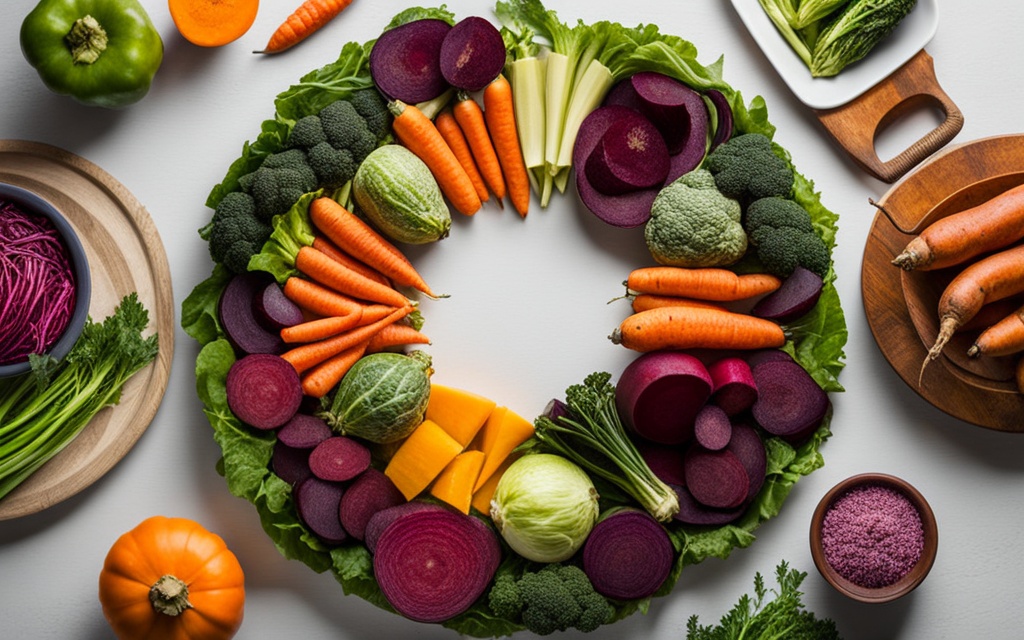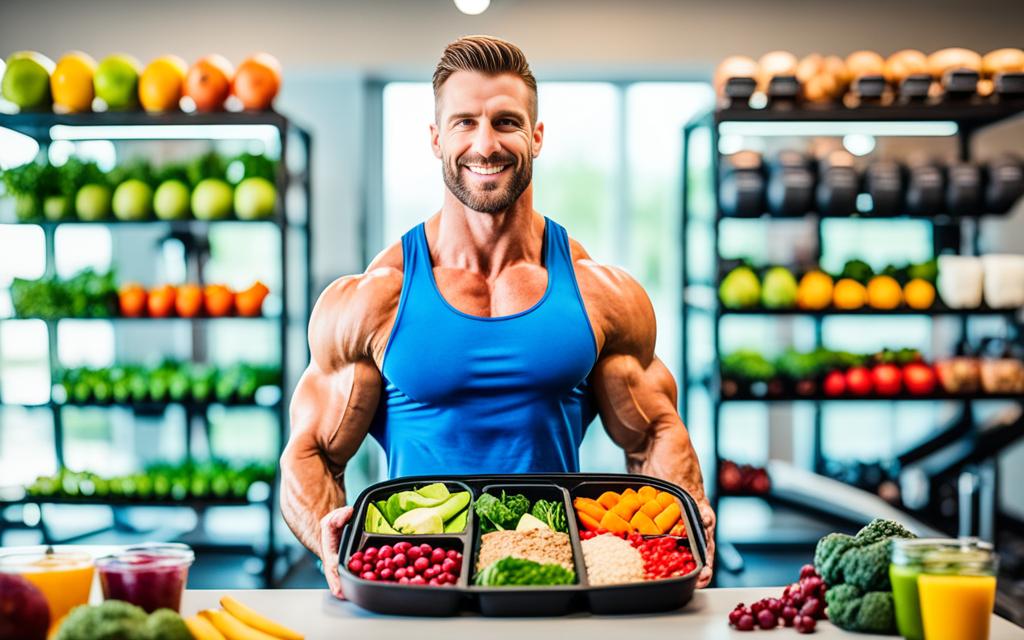Welcome to our guide on the cutting diet plan for men. We offer a strategy for a lean, muscular body through smart nutrition, training, and lifestyle choices. If you aim to lose fat, show off muscle, or change your body completely, this plan is for you. Get set for a journey to a leaner, more defined you.
Table of Contents
ToggleUnderstanding the Cutting Diet
A cutting diet plan focuses on creating a calorie deficit. It helps in losing fat while keeping muscle. You do this by watching what you eat and exercising smartly.
What is a Cutting Diet?
A cutting diet aims to gain more energy from fat. This means you eat fewer calories than you use. It’s about finding the right balance to lose fat but keep your muscles.
Benefits of a Cutting Diet for Men
Following a cutting diet can help men get a defined body. It burns fat but saves your muscles. Plus, it boosts your health, metabolism, and how your body handles sugar.
Setting Realistic Goals
Embarking on a cutting diet for men means setting goals that are realistic and doable. These goals will be like a roadmap for you. They’ll keep you motivated no matter what your aim is, like losing body fat, changing your body shape, or just feeling better about yourself.
Determining Your Calorie Deficit
A key part of your cutting diet is figuring out the right calorie deficit. This means eating fewer calories than your body uses. It helps you burn fat for energy, leading to steady weight loss without hurting your muscle or health.
Tracking Progress and Adjustments
Keeping track of your progress is really important in your cutting diet plan. It means watching your body’s changes, your weight, and how your plan is working. You can tweak things like how many calories you eat, your diet balance, or your workout to keep improving. Using data to guide your choices helps a lot.
Macronutrient Breakdown
To achieve your cutting diet goals, men need a smart strategy with macronutrients. These are protein, carbs, and fats. Each one has a special role in your plan to lose fat, keep muscle, and stay healthy.
Protein: The Building Block of Lean Muscle
Protein is key for keeping and growing lean muscle during a cutting diet. Eating enough from sources like chicken, fish, and lean meats helps keep your muscles. Try to get 1.6-2.2 grams of protein per kilogram of your weight every day.
Carbohydrates: Fueling Your Workouts
Even though you might eat fewer carbs when cutting, choose well to keep your workouts going. Pick complex carbs from whole grains, veggies, and fruits with lots of fiber. These give you lasting energy and help you feel full, supporting your diet.
Healthy Fats: Essential for Hormonal Balance
Don’t cut out healthy fats from your diet – they’re vital. Foods like avocados, nuts, olive oil, and fish are good choices. They help make hormones, absorb nutrients, and keep you healthy. This is crucial for a successful cutting plan.
Balancing your macronutrients right helps with fat loss and muscle saving. Remember, the best mix can vary based on your goals. Always consult a professional to fine-tune your cutting diet.
Cutting Diet Plan for Men
To make a successful cutting diet plan, it’s vital to plan meals carefully. Thoughtful meal and snack planning can make your diet work well. We offer practical tips to smoothly add a cutting diet to your life.
Meal Planning and Preparation
Meal prepping is a big step towards cutting diet success. When you prep your meals, you control what nutrients your body gets. This helps meet your cutting goals. Spend a few hours every week making meals with lean proteins, complex carbs, and healthy fats.
Grocery Shopping Tips
To help with meal prepping, it’s key to have the right foods at home. Focus on buying lean proteins (chicken, turkey, fish), complex carbs (quinoa, oats, veggies), and good fats (avocados, nuts, olive oil) when you shop. This keeps your kitchen ready for healthy meals and stops you from choosing less healthy foods.
Lean Protein Sources
Lean protein sources are key for a cutting diet aimed at men. These foods are full of nutrients. They help build and keep muscle while helping you stay full. This is important on your journey to lose weight. Discover the top lean proteins you should eat every day.
Chicken and Turkey
Chicken and turkey are great for a cutting diet. They are low in fat and high in quality protein. Eating them helps keep your muscle strong. You can cook chicken and turkey in many ways. Add them to salads, stir-fries, or sandwiches for a tasty meal.
Fish and Seafood
Include fish and seafood in your diet for many advantages. Fatty fish like salmon is a lean protein with heart-healthy fats. They also have omega-3s, which are good for you. Other seafood like shrimp and cod are low in fat too, making them perfect for your diet plan.
Lean Cuts of Beef and Pork
Red meat is okay in small amounts in your diet. But choose lean cuts like sirloin or pork loin. These are good for your muscles and keep you feeling full. Remember, you can still enjoy these meats while on a cutting diet. Just eat them wisely.
Carbohydrate Sources for Cutting
When you’re on a cutting diet, getting the right amount of carbs is key. It’s important to lower your carb intake to help cut calories. But, it’s also crucial to pick the right carbs that will keep you feeling full, boost your workouts, and maintain good health.
Complex Carbs: Whole Grains and Vegetables
Focus on getting complex carbs from whole grains and veggies during your cut. These foods give you lasting energy. They are packed with important vitamins, minerals, and fiber.
For complex carbs, go for brown rice, quinoa, oats, and sweet potatoes. Also, eat plenty of broccoli, spinach, and asparagus.
Fiber-Rich Carbs for Satiety
Eating carbs high in fiber is great for your cut diet. Foods like whole grains, legumes, and greens can help you feel full. This makes it easier to control your calories and stick to your diet plan. Don’t forget to add these fiber-rich carbs to your meals and snacks for better weight and muscle gains.

Healthy Fat Sources
A cutting diet for men needs fewer calories but must include healthy fats. Fats are key for making hormones, taking in nutrients, and staying healthy. We’ll look at the top sources of fats you can use in your diet.
Avocados and Nuts
Avocados and nuts offer great healthy fats. Avocados have a lot of good oleic acid. They also give you important vitamins, minerals, and fiber. Nuts like almonds, walnuts, and cashews are full of fats, protein, and antioxidants. These can help with your diet goals.
Olive Oil and Fatty Fish
Olive oil is main in the Mediterranean diet. It’s known for having a lot of good monounsaturated fats, like oleic acid. Adding olive oil to meals or salads boosts the diet’s fat level in a good way. Fatty fish, such as salmon, mackerel, and sardines, are great sources of omega-3. These fats fight inflammation and help muscles recover.
Resistance Training for Muscle Preservation
Men, listen up! A well-planned resistance training is key on a cutting diet. It helps keep your muscle while losing fat. This way, your body stays toned and strong.
Compound Exercises for Maximum Efficiency
To make your workouts count, focus on exercises that work many muscles. Squats, deadlifts, and bench presses are top choices. They help you increase muscle and burn more fat faster.
Progressive Overload and Periodization
Here’s a tip: keep making your workouts tougher over time. This is what we call progressive overload. Also, mix up your routines regularly to keep your body guessing. It’ll help you avoid hitting a plateau in your progress.
Cardio for Fat Loss
Resistance training is key for keeping and growing lean muscle during a cutting diet. Adding targeted cardio boosts fat loss too. Let’s look at two top cardio methods for your cutting plan: High-Intensity Interval Training (HIIT) and Low-Intensity Steady-State Cardio (LISS).
High-Intensity Interval Training (HIIT)
HIIT mixes short bursts of intense exercise with active recovery. Studies show it’s great for losing fat. HIIT ramps up your metabolism, making you burn more fat even after you’re done exercising. Include things like sprints, cycling, or rowing in your plan. Make sure you really push yourself during the intense parts.
Low-Intensity Steady-State Cardio (LISS)
LISS is about easy, steady exercise for a longer time. It’s good for dropping fat without hurting your muscle. Adding in brisk walking, light jogging, or moderate cycling can help. This complements your HIIT sessions well.
Using both HIIT and LISS can really boost your fat loss while keeping your muscles strong. It’s important to pay attention to how your body feels. Slowly up the intensity and time of your cardio. Tweak your plan to find what works best for you.
Hydration and Supplements
Staying hydrated and using supplements smartly are key on a cutting diet. They help your health and performance by boosting your body’s functions and keeping muscle when losing fat.
Importance of Proper Hydration
Hydration is vital during a cutting diet. It helps with muscle recovery, keeps your body cool, and moves nutrients. Drinking enough water keeps your body working well and avoids the bad parts of dehydration.
Supplements to Consider
Whole, rich foods are the main goal in a cutting diet. But, some supplements can help with extra fat loss and saving muscle:
- Whey Protein: It’s top for muscle building and repair.
- Creatine: Boosts muscle strength, helping with intense exercise.
- Omega-3 Fish Oils: They help fight inflammation and boost health.
- Caffeine: It sharpens focus, lifts energy, and speeds up fat burn, but not too much is best.
- Vitamin D: It’s key for bones, immune system, and regulating hormones.
Don’t forget, talk to a doctor before adding any supplement to your cutting diet. This helps make sure they are safe and right for you.
Mindset and Consistency
Achieving your cutting diet goals takes more than a plan for food and exercise. It’s about having the right mindset and being consistent. This is key for finding long-term success. We’ll look at how to keep going, even if you face obstacles or get off track.
Overcoming Plateaus and Setbacks
On your cutting diet, you might hit plateaus or face setbacks. They are normal and not the end of the road. Think of them as chances to learn and adjust. Keep track of your food, exercise, and see where you can improve. With time and hard work, you can get past these and be even stronger.
Staying Motivated and Disciplined
Staying motivated and disciplined is vital for your diet to work. Take joy in small wins, like meeting your weekly weight loss goal. It’s also key to have support, whether from friends or an online group. Keep your goal in mind. This will help you stay focused. Stay consistent, even when it’s hard. You will see changes in your body and mindset over time.
Conclusion
We’ve given you key info and a plan for a strong, lean body with a cutting diet for men. This guide covers the basics, like what to eat, how to train, and the importance of cardio. Now, you have what it takes to transform your body.
Remember, set achievable goals and monitor your progress. Be ready to change your plan if needed. Being regular and disciplined is crucial. Keep your motivation high and stick to your cutting diet.
You now have all the tools to start this journey. Enjoy the challenge, believe in the method, and share your success stories with us. Good luck on your cutting diet plan for men!
FAQ
What is a cutting diet, and how does it differ from other weight loss plans?
A cutting diet is a special way of eating and exercising. It’s done to lose body fat but keep your muscles. It focuses on eating the right amount of proteins, carbs, and fats. You also do specific exercises to look lean and strong. This is different from normal diets that might only focus on losing weight.
What are the benefits of a cutting diet for men?
Men experience several advantages with a cutting diet. They lose fat while keeping or even increasing their muscle. This improves how they look, perform in sports, and their overall health. Watching your calories and choosing what you eat can make a big difference in fat loss and muscle gain.
How do I determine my calorie deficit for a cutting diet?
First, figure out how many calories you need each day without gaining or losing weight. Then, based on that number, reduce your daily intake by 300 to 500 calories. This is your calorie deficit. It helps your body burn fat but keeps your muscles strong.
What is the optimal macronutrient breakdown for a cutting diet?
In a cutting diet, you should eat more protein than usual. Think about 0.7 to 1 gram for each pound you weigh. Carbs and fats should be moderate. This mix supports muscle health, energy for workouts, and weight loss.
What are some of the best lean protein sources to include in a cutting diet?
Great sources of protein for a cutting diet include chicken, turkey, and fish. Also, eggs, lean meats, and low-fat dairy. These foods are good for your muscles but are not heavy in calories. They help your body repair and grow stronger.
How can I incorporate resistance training to preserve muscle mass during a cutting diet?
Adding strength exercises can help you keep your muscles during a cutting diet. Use moves that work more than one muscle at the same time. By increasing the challenge of your exercises over time, you can get stronger and protect your muscles.
What types of cardio exercises are most effective for fat loss during a cutting diet?
For burning fat, try High-Intensity Interval Training (HIIT) and Low-Intensity Steady-State (LISS) cardio. HIIT boosts your metabolism. LISS keeps burning fat without hurting muscle growth.
How important is hydration and supplementation in a cutting diet plan?
Drinking enough water and using the right supplements help a lot. Hydration is key for your health, muscle recovery, and using nutrients. Supplements like protein powders and certain vitamins can offer extra help in reaching your body goals.
What are some strategies for overcoming plateaus and staying motivated during a cutting diet?
To stay motivated, be patient and consistent. Keep track of your progress and adjust your diet and exercise if you hit a plateau. Find new ways to enjoy staying fit. This can be key in pushing through tough times and reaching your goals.



